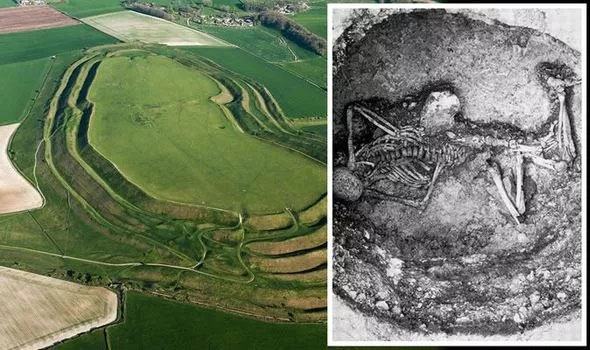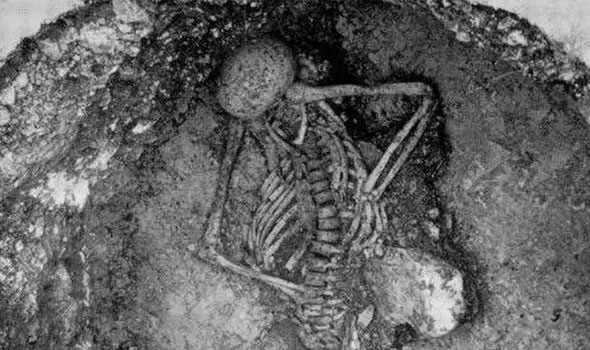Researchers were astonished to discover a skeleton from the Iron Age buried in a sitting position at the ruins of the Maiden Castle in the United Kingdom. They believe this is evidence of a brutal sacrifice.
Maiden Castle is one of the largest and most complex Iron Age hill forts in Europe.

The skeleton found buried in a strange position. (Photo Express).
The size of this castle is equivalent to 50 football fields. It houses many massive ramparts, most of which were built in the first century BC, once protected by hundreds of inhabitants. When it was first constructed, these ramparts towered over the surrounding landscape.
Excavations have been ongoing in this area for many years and have yielded significant results regarding the history of England.
Among these findings is a Neolithic enclosure dating back to around 3500 BC and a Roman temple built in the 4th century AD.
Archaeologists have also found evidence of a late Iron Age cemetery, where many of those buried suffered horrific injuries.
One of the corpses found in the graves that has attracted scholarly interest was featured in the 2020 Smithsonian Channel documentary titled “The Mysterious Britons.”

The skeleton buried upright known as “the Mysterious Briton.” (Photo Express).
According to Professor Neil Sharples, an archaeologist at Cardiff University, who has spent decades investigating Iron Age hill forts.
More than 80 years ago, a body was excavated from this fort, and as Clive Anderson, the narrator of the documentary noted, “there was something very unusual about the burial” of this body.
“At the bottom of this pit is a grave of a young man, possibly between 20 and 30 years old, and he appears to be sitting at the bottom of this pit,” Professor Sharples stated.
Most of the recorded burials from the Iron Age were in a fetal position or curled up, not sitting upright, but this young man’s body is different.
Besides the unusual burial position, Professor Sharples believes that the placement of the body is also “very significant.”
“Around 350 BC, they decided to expand and transform Maiden Castle into the largest hill fort in the area. But there is a massive ditch right in front that looks like the flat ground today, but it is actually a 6-meter deep, V-shaped ditch. This ditch was later filled in, and they built a new rampart.”
The new rampart was the very place where the young man’s body was buried.
“Clearly, this was a deliberate sacrifice to mark this additional construction – the expansion of the hill fort,” Sharples explained regarding the hypothesis that the young man was sacrificed.


















































